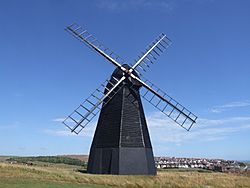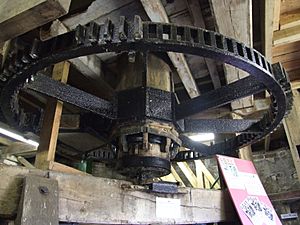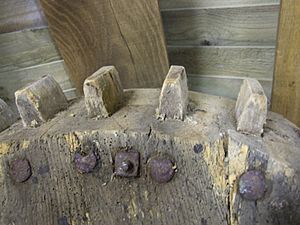Beacon Mill, Rottingdean facts for kids
Quick facts for kids Rottingdean Windmill |
|
|---|---|

The mill in 2010
|
|
| Origin | |
| Mill name | Beacon Mill New Mill |
| Mill location | TQ 366 025 |
| Coordinates | 50°48′22″N 0°03′47″W / 50.806°N 0.063°W |
| Operator(s) | Rottingdean Preservation Society |
| Year built | 1802 |
| Information | |
| Purpose | Corn mill |
| Type | Smock mill |
| Storeys | Three-storey smock |
| Base storeys | Single-storey base |
| Smock sides | Eight sides |
| No. of sails | Four sails |
| Type of sails | Patent sails |
| Windshaft | Cast iron |
| Winding | Fantail |
Beacon Mill, also called New Mill, is a special type of windmill known as a smock mill. You can find it in Rottingdean, England. This historic building was built in 1802 and is considered a "Grade II listed building." This means it's an important historical structure that needs to be protected. Today, it stands tall and has been restored to serve as a landmark.
Contents
The Mill's Story: A Look Back in Time
Building the Mill: 1802
Beacon Mill was built in the year 1802. Before this mill, there might have been an older windmill on the same spot. When workers were digging the ground for the new mill's foundations, they found something interesting. They discovered a human skeleton, which they thought belonged to an "ancient warrior" with a sword. However, these remains later went missing.
Challenges and Repairs: The Mill's Journey
The mill was busy grinding corn until 1881. By 1890, it was in very poor condition. People even thought about tearing it down. But in 1905, a person named the Marquis of Abergavenny paid to have it fixed.
Sadly, by the early 1920s, the mill was falling apart again. It wasn't until 1935 that it got another big restoration. Special builders called millwrights from a company named Neve's helped repair it. New sails for the mill were made by Holman's, another millwright company.
Modern Support: Keeping the Mill Standing
In 1969, the mill was leaning to one side. To help it stand strong, another company called Hole's put a steel frame inside the mill. This frame helps support the building. They also added new sails. In 1974, this steel frame was extended even further into the top part of the mill.
How Beacon Mill Looks
Beacon Mill is a smock mill, which means it has a wooden tower that looks a bit like a farmer's smock (a loose shirt). It has three main floors above a single brick base. The top part of the mill, called the cap, is built in a style common in Kent.
The mill has four large sails that catch the wind. These are called "Patent sails." Originally, the mill also had a special tail called a fantail. This fantail would automatically turn the mill's cap to face the wind. However, the fantail is now missing.
Beacon Mill in Pop Culture
A Famous Logo: Heinemann Publishers
The Rottingdean windmill was the inspiration for a well-known logo. It became the trademark for the publishing company Heinemann. A local artist named Sir William Nicholson, who lived in Rottingdean, designed it. If you look at older Heinemann books, you might see this windmill engraved on the back cover. Even though the Rottingdean Mill inspired him, Sir William Nicholson actually based his final design on an older Dutch windmill. Modern versions of this windmill logo are still used by Heinemann today.
Music Connections
Beacon Mill has also appeared in music! It was featured on the front cover of an album called "Vale Industrial" by a band from Brighton called The Tenderfoot. The mill also showed up in the music video for the song That Old Pair of Jeans by the famous DJ Fatboy Slim.
Visiting Beacon Mill
You can visit Beacon Mill and see it up close! It is usually open to the public on specific days. You can visit from 2:00 PM to 4:30 PM on both days of the National Mills Weekend. It's also open on the third Sunday of each month, from May through September.



